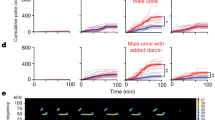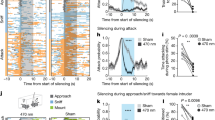Abstract
Investigations of aggression chemosignals in mammals have mostly involved lesioning a chemosensory system, e.g., chemically-induced anosmia, or surgically eliminating the glandular source of putative pheromones, e.g., preputial-glandectomy (Lee and Ingersoll, 1983). Typically, interactive behavioral tests with the altered animals or their modified chemosignals have been used to assess the possible chemosensory coordination of aggression. The recent development of genetically-engineered house mice having targeted mutations or disruptions of single genes presents an innovative and highly focused level of analysis in chemosignal studies of sociosexual behaviors, not only in ascertaining the appropriate chemosensory receptors (Mombaerts, 1999), but also in identifying the cellular sources and chemical identities of pheromones (Kingsley, 1998). This report is a description of efforts to develop a behavioral test for aggression chemosignals in male house mice.
Access this chapter
Tax calculation will be finalised at checkout
Purchases are for personal use only
Preview
Unable to display preview. Download preview PDF.
Similar content being viewed by others
References
Albone, E. S., 1984, Semiochemistry: The Investigation of Chemical Signals Between Mammals. John Wiley and Sons Limited, New York.
Beynon, R. J., Roberston, D. H. L., Hubbard, S. J., Gaskell, S. J., and Hurst, J. L., 1999, The role of protein binding in chemical communication: major urinary proteins in the house mouse, in:Advances in Chemical Signals in Vertebrates, (R. E. Johnston, D. Müller-Schwarze, and P. W. Sorensen, eds.), Kluwer Academic/ Plenum Publishers, New York, pp. 137-148.
Chen, W., Kelly, M. A., Opitz-Araya, X., Thomas, R. E., Low, M .J., and Cone, R. D., 1997, Exocrine gland dysfunction in MC5-R-deficient mice: evidence for coordinated regulation of exocrine gland function by melanocortin peptides,Cell 91:789-98.
Ebling, F. J., Ebling, E., Skinner, J., and White, A., 1970, The response of the sebaceous glands of hypophysectomized-castrated male rats to andrenocorticotrophic hormone and to testosterone,J.Endocr.48:73-81.
Hayashi, S., 1987, The effects of preputialectomy on aggression in male mice,Zool. Sci.4:551-555.
Ingersoll, D. W., Morley, K. T., Benvenga, M., and Hands, C, 1986, An accessory sex gland aggression promoting chemosignal in male mice,Behav. Neurosci.100:777-782.
Jones, R. B., and Nowell, N. W., 1973, Effects of preputial and coagulating gland secretions upon aggressive behaviour in male mice: a confirmation,J.Endocr.59:203-204.
Kingsley, H. K., 1998, Disruption of the fifth melanocortin receptor alters intermale aggression pheromones in house mice, unpublished M.S. thesis, University of North Carolina at Greensboro, Department of Biology, 69 pages.
Lee, C., and Ingersoll, D. W., 1983, Pheromonal influence on aggressive behavior, in:Hormones and Aggressive Behavior, (B. B. Svare, ed.), Plenum Press, New York, pp. 373-392.
McKinney, T. D., and Christian, J. J., 1970, Effect of preputialectomy on fighting behavior in mice,Proc. Soc. Exp. Bio. Med.134:291-293.
Mombaerts, P., 1999, Seven-transmembrane proteins as odorant and chemosensory receptors.Science 286:707-711.
Novotny, M., Harvey, S., and Jemiolo, B., 1990, Chemistry of male dominance in the house mouse,Mus domesticus, Experientia 46:109-113.
Nowell, N. W., Thody, A. J., and Woodley, R., 1980. α-Melanocyte stimulating hormone and aggressive behavior in the male mouse.Physiol.Behav.24:5-9.
Tatro, J. B., and Reichlin, S., 1987, Specific receptors for α-melanocyte-stimulating hormone are widely distributed in tissues of rodents.Endocrinology 121:1900-1907.
Thody, A. J., and Shuster, S., 1973, Possible role of MSH in the mammal.Nature 245:207-209.
Thody, A. J., Cooper, M. F., Bowden, P. E., Meddis, D., and Shuster, S., 1976, Effect of α-melanocytestimulating hormone and testosterone on cutaneous and modified sebaceous glands in the rat,J.Endocr.71:279-288.
Todrank, J., Heth, G., and Johnston, R. E., 1999, Kin and Individual Recognition: odor signals, social experience, and mechanisms of recognition, in:Advances in Chemical Signals in Vertebrates, (R. E. Johnston, D. Müller-Schwarze, and P. W. Sorensen, eds.), Kluwer Academic/ Plenum Publishers, New York, pp. 289-298.
Author information
Authors and Affiliations
Editor information
Editors and Affiliations
Rights and permissions
Copyright information
© 2001 Springer Science+Business Media New York
About this chapter
Cite this chapter
Caldwell, H.K., Wang, L., Lepri, J.J. (2001). Simplified Tests of Aggression Chemosignals in Male House Mice Suggest that a Melanocortin-Dependent Product of the Preputial Gland Reduces Attacks. In: Marchlewska-Koj, A., Lepri, J.J., Müller-Schwarze, D. (eds) Chemical Signals in Vertebrates 9. Springer, Boston, MA. https://doi.org/10.1007/978-1-4615-0671-3_61
Download citation
DOI: https://doi.org/10.1007/978-1-4615-0671-3_61
Publisher Name: Springer, Boston, MA
Print ISBN: 978-1-4613-5187-0
Online ISBN: 978-1-4615-0671-3
eBook Packages: Springer Book Archive




